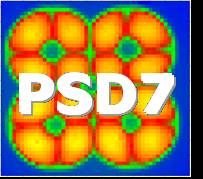Speaker
Dr
Masaki Katagiri
(Japan Atomic Energy Research Institute)
Description
High-intensity pulsed neutron sources have made a great deal of
progress at Japan (J-PARC project), U.S.A. (SNS project), and UK
(ISIS-II project). The specifications required for neutron imaging
detectors used at these facilities are a high-position resolution,
high-detection efficiency, a high counting rate, a high n/ ratio,
etc. Especially the detectors which exhibit a high-position
resolution and high detection efficiency are required for the
crystallography diffractometers. Moreover, it is also essential for
these detectors to be compact and to have the least dead-detection
area for a large solid-angle coverage.
We have developed a compact high-position-resolution neutron-imaging
detector with wavelength shifting (WLS) fibers using two
scintillator sheets. The two ZnS:Ag/6LiF scintillator sheets are
placed in front and back side of the crossed WLS fibers arrays. The
luminescent light generated in either scintillator sheet is detected
by few WLS fibers surrounding to the incident point of the neutron.
The X and Y positions of the incident neutron are measured by the
photon counting method or by the double coincidence method. The WLS
fibers are bent at right angle at the edges of the scintillator
sheets to reduce the dead-detection area of the detector. The
developed detector structure ensures compactness and easy assembly
of these types of detectors.
It was confirmed that the neutron imaging detector using WLS fibers
with a size of 0.5 x 0.5 mm exhibited a position resolution of less
than 0.8 mm. The detection efficiency for thermal neutrons was
improved 55% by two scintillator sheets from 29% by the single sheet.
Primary author
Dr
Masaki Katagiri
(Japan Atomic Energy Research Institute)
